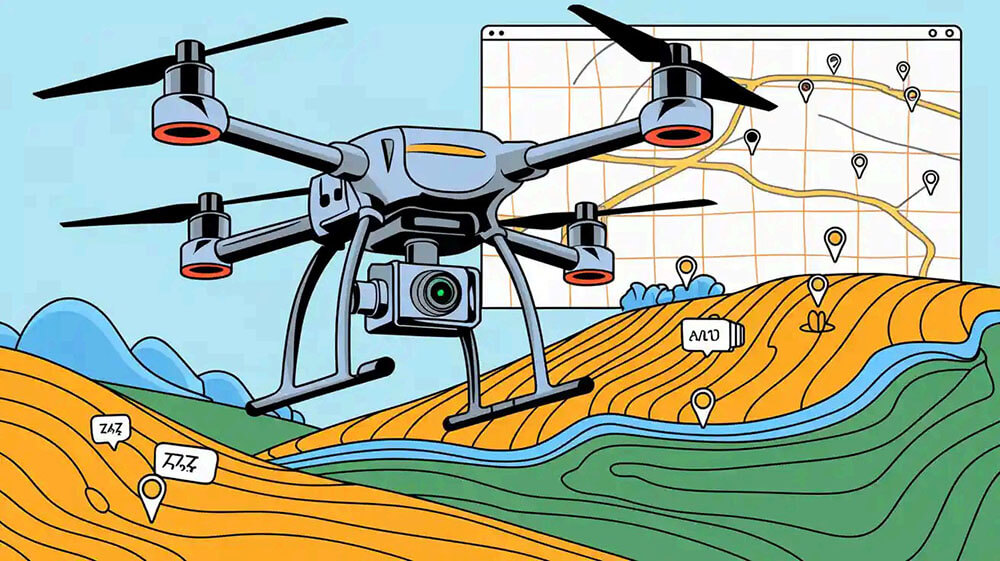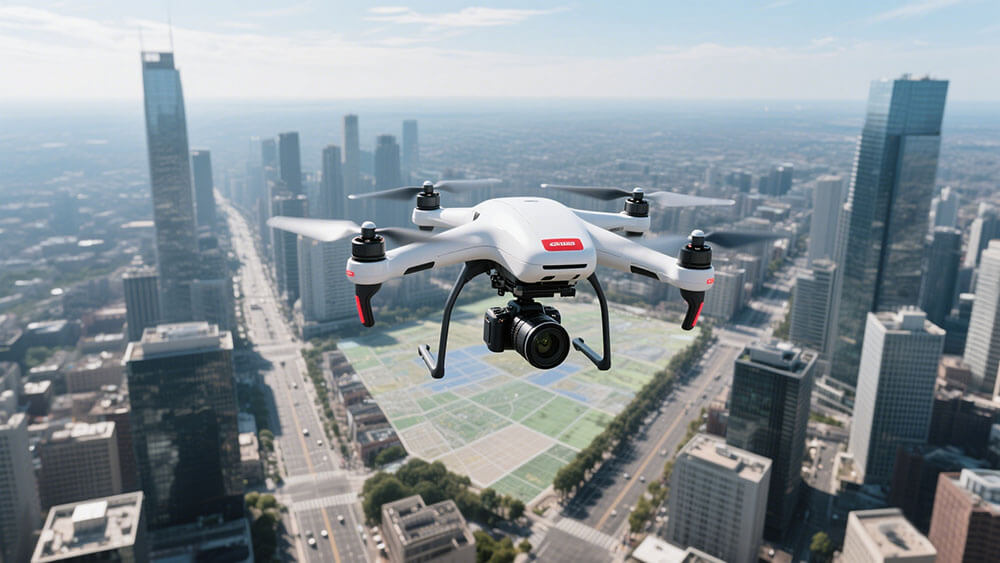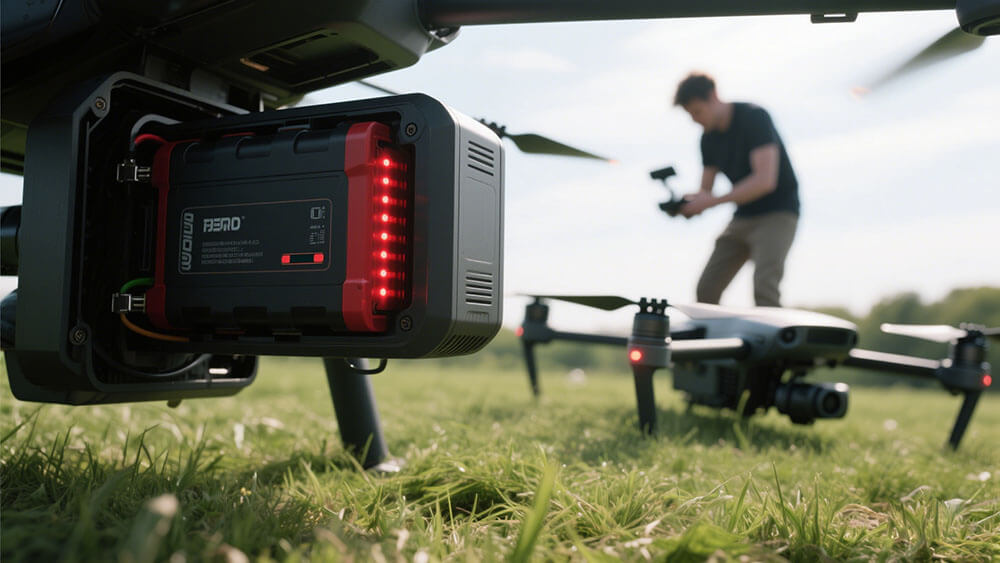Contents

When it comes to drone mapping, the lithium battery of drone mapping you select plays a critical role in determining how well your drone performs. High energy density ensures your drone can stay in the air longer without adding excessive weight. Advanced technologies have pushed gravimetric energy densities in lithium batteries to nearly 300 Wh/kg, but further improvements are vital for professional mapping applications. Lightweight options, like Lithium Polymer (LiPo) batteries, offer superior weight-to-power ratios, which directly enhance flight time and payload efficiency. Choosing the right lithium battery of drone mapping also means prioritizing reliability and safety to prevent mid-flight failures or thermal issues. A dependable battery ensures consistent performance, even in demanding environments.
Key Takeaways
Pick a lithium battery with lots of energy for longer flights and carrying more weight during drone mapping.
Focus on batteries with safety features like heat control to stop overheating and work well in different places.
Take care of your battery by storing it right and not overdischarging. This helps it last much longer.

Part 1: Key Qualities of a Lithium Battery for Drone Mapping
1.1 Energy Density and Weight-to-Power Ratio
When selecting a lithium battery for drone mapping, energy density and weight-to-power ratio are critical factors. A high energy density ensures that your drone can achieve extended flight times without compromising its payload capacity. Lithium-ion batteries, for instance, offer gravimetric energy densities ranging from 100 to 270 Wh/kg, with top-tier models reaching approximately 300 Wh/kg. This makes them ideal for professional mapping applications where efficiency and endurance are paramount.
The weight-to-power ratio also plays a significant role in drone performance. Lightweight batteries, such as lithium-polymer (LiPo) batteries, excel in this area. Their reduced weight allows drones to carry additional equipment, such as high-resolution cameras or advanced sensors, without sacrificing flight time. This balance between energy density and weight-to-power ratio directly impacts the efficiency of your mapping operations.
Tip: Opt for a high-capacity battery with a superior weight-to-power ratio to maximize your drone’s performance during mapping missions.
1.2 High Discharge Rate and Short Charging Time
High current discharge capabilities are essential for drones that require bursts of power during takeoff, rapid maneuvers, or when carrying heavy payloads. LiPo batteries are particularly suited for these scenarios due to their ability to deliver high discharge rates. This makes them a preferred choice for mapping drones that demand quick and efficient power delivery.
Short charging times are equally important, especially for commercial mapping operations where downtime can lead to productivity losses. Lithium-ion batteries stand out in this regard, offering faster recharge cycles compared to traditional battery technologies. This ensures that your drone spends more time in the air and less time on the ground, enhancing overall operational efficiency.
LiPo batteries excel in high-discharge scenarios, making them ideal for high-energy-demand tasks.
Both battery types contribute to improved efficiency, depending on the specific requirements of your mapping project.
1.3 Safety and Thermal Stability
Safety is a non-negotiable aspect of any battery used in drone mapping. Lithium batteries are designed with advanced safety features to prevent thermal runaway, a condition that can lead to overheating or even combustion. Among the various lithium battery chemistries and balancing energy density, NMC batteries are renowned for their exceptional thermal stability and safety profile. These batteries operate within a stable voltage range and are less prone to overheating, making them suitable for industrial applications and harsh environments.
Thermal stability also ensures consistent performance across a wide range of temperatures. This is particularly important for mapping drones that operate in diverse environmental conditions, from scorching deserts to freezing mountain ranges. By choosing a high-capacity battery with robust safety features, you can minimize risks and maintain reliable performance throughout your mapping missions.
Note: Always prioritize safety when selecting a battery for your drone. Consider consulting with Large Power to find a custom solution tailored to your specific needs.

Part 2: Revolutionizing Drone Applications with Lithium Battery Technology
2.1 Endurance Revolution: Expanding Missions from “Minutes” to “Hours”
Key Drivers:
High-Energy-Density Cells (300–400 Wh/kg):
Solid-state batteries double the energy density of traditional LiPo, extending flight times for agricultural drones from 25 minutes to 80 minutes, enabling single-session coverage of 50 hectares.Hybrid Energy Systems:
Lithium battery + hydrogen fuel cell hybrids enable 6-hour continuous flight for power line inspections or border patrols.
Industry Disruption:
Delivery Drones:
Zipline’s African medical supply drones use high-nickel NMC batteries (350 Wh/kg) to achieve 160 km range, delivering emergency medicines 20 times daily.Ocean Monitoring:
Saildrone weather monitoring drones paired with silicon-anode lithium batteries operate for 90 days, crossing the Pacific to collect real-time climate data.
2.2 Environmental Adaptability Revolution: Unlocking Polar, Deep-Sea, and Space Applications
Key Drivers:
Full-Temperature-Range Batteries:
Graphene-based self-heating batteries retain >95% capacity at -40°C, enabling Arctic glacier surveying drones to operate without preheating.Waterproof/Pressure-Resistant Designs:
Deep-sea drone batteries with titanium casing + gel electrolytes withstand 6,000-meter depths.
Industry Disruption:
Polar Research:
British Antarctic Survey drones with LTO batteries map ice sheet thickness at -50°C, achieving 45-minute flights.Space Exploration:
NASA’s Mars helicopter Ingenuity uses radiation-resistant lithium batteries to complete 33 flights in thin Martian atmosphere.
2.3 Intelligence Revolution: From “Power Supply” to “Smart Energy Brain”
Key Drivers:
AI-BMS Systems:
Machine learning-based health prediction warns of cell failures 48 hours in advance, reducing failures by 70%.Wireless Charging Networks:
Laser charging stations + task allocation algorithms enable drone swarms for 24/7 urban surveillance.
Industry Disruption:
Smart Agriculture:
XAG agricultural drones upload real-time fertilization data via smart batteries, with AI optimizing routes to boost efficiency by 40%.Disaster Response:
DJI Matrice 30T with bidirectional fast-charging batteries (80% in 20 minutes) completes 200 rescue sorties within 72-hour golden windows.
Breakthroughs in lithium battery technology are fundamentally transforming drone capabilities, from overcoming endurance limitations to enhancing extreme-environment adaptability and advancing intelligent energy management. Drones are evolving from “limited tools” into “versatile platforms.”

Part 3: Performance and Maintenance in Drone Mapping
3.1 Flight Time and Payload Efficiency
Optimizing flight time and payload efficiency is crucial for successful drone mapping. The relationship between these two factors directly impacts the overall performance of your drone. Heavier payloads, such as LiDAR systems or high-resolution cameras, often reduce flight times. However, advanced drones like the Skyfront Perimeter 8 can carry heavier payloads while maintaining extended flight durations.
Selecting a battery with high capacity and efficiency ensures your drone can handle demanding mapping tasks without compromising performance.
Tip: Balance payload weight and battery capacity to maximize efficiency during mapping missions.
3.2 Environmental Adaptability and Stability
Environmental conditions significantly influence drone battery performance. Extreme temperatures, strong winds, and high altitudes can drain battery capacity faster. Lithium-ion batteries, known for their adaptability, perform well across diverse terrains, from urban infrastructure to remote wilderness. Their consistent output ensures reliable performance even in challenging environments.
Thermal stability is another critical factor. Batteries like LiPo excel in maintaining stability under extreme conditions, making them ideal for industrial applications. For mapping in harsh climates, prioritize batteries with robust thermal management systems to ensure uninterrupted operations.
Note: Always consider environmental factors when planning mapping missions to optimize battery performance and efficiency.
3.3 Drone Battery Guide for Maintenance and Longevity
Proper maintenance is essential to extend drone battery life and ensure consistent performance. Follow these best practices:
Store batteries in a cool, dry place to prevent capacity loss.
Avoid overcharging or deep discharging, as these can shorten battery lifespan.
Regularly inspect batteries for physical damage or swelling.
Use manufacturer-recommended chargers to maintain optimal battery performance.
Factor | Impact on Battery Life |
|---|---|
Battery Capacity | Higher capacity batteries offer longer flight times. |
Flight Conditions | Cold weather and strong winds can drain battery faster. |
Maintenance | Regular upkeep extends battery life and efficiency. |
By adhering to these guidelines, you can maximize drone battery life and reduce operational costs. For custom battery solutions tailored to your needs, consult experts at Large Power.
Selecting the right battery for drone mapping ensures optimal performance and efficiency. High energy density, safety, and adaptability make lithium-ion and LiFePO4 batteries ideal for professional applications. For small drones, batteries below 3000mAh suffice, while mid-sized drones benefit from 3000-5000mAh capacities. Large drones require high-capacity batteries exceeding 5000mAh to support extended flight times and heavier payloads. Proper maintenance, such as avoiding overcharging and storing in cool conditions, extends battery lifespan and reduces operational costs. Consult experts at Large Power for tailored solutions.
FAQ
1. What is the best type of battery for drone mapping?
Lithium batteries are ideal for drone mapping. They offer high energy density, long flight times, and reliable performance across various environmental conditions.
Tip: For professional guidance on custom battery solutions, visit Large Power.
2. How can you extend the lifespan of your drone battery?
Store batteries in a cool, dry place. Avoid overcharging or deep discharging. Regularly inspect for damage and use manufacturer-recommended chargers for optimal performance.
3. Why is thermal stability important in lithium battery of drone mapping?
Thermal stability ensures consistent performance in extreme temperatures. It prevents overheating, which can lead to battery failure or safety hazards during mapping missions.





